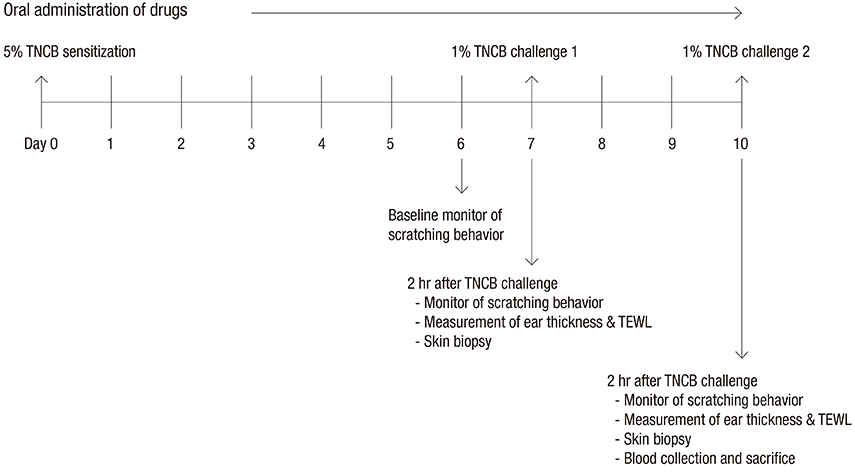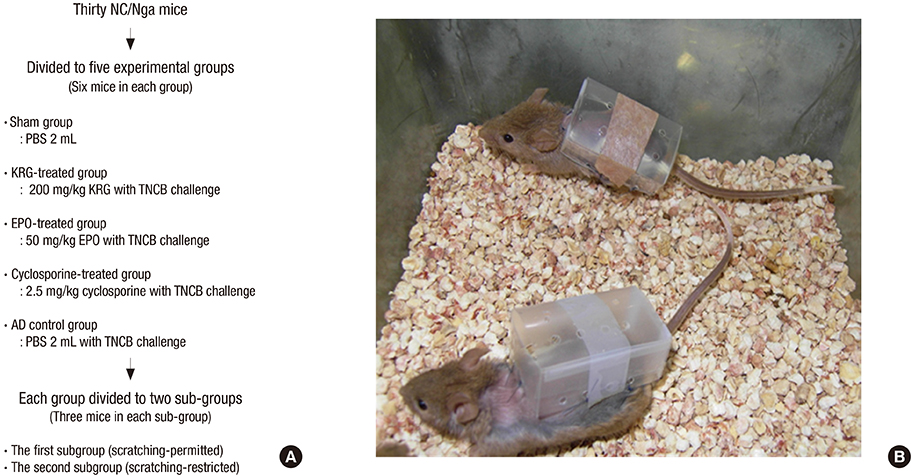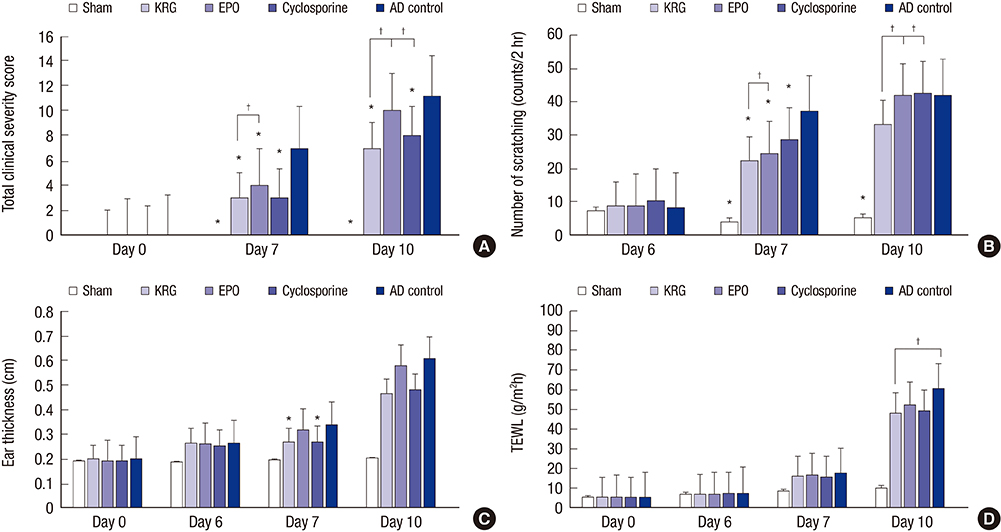J Korean Med Sci.
2017 Apr;32(4):679-687. 10.3346/jkms.2017.32.4.679.
Therapeutic Effects of Korean Red Ginseng Extract in a Murine Model of Atopic Dermatitis: Anti-pruritic and Anti-inflammatory Mechanism
- Affiliations
-
- 1Department of Dermatology, The Catholic University of Korea College of Medicine, Incheon St. Mary's Hospital, Incheon, Korea. drchosh@hotmail.com
- KMID: 2371456
- DOI: http://doi.org/10.3346/jkms.2017.32.4.679
Abstract
- Korean red ginseng (KRG) and ginsenosides exhibit diverse biological effects, including anti-inflammatory and anti-allergic. We aimed to investigate the therapeutic effect of KRG in a murine model of atopic dermatitis (AD) is mediated whether by diminishing the pruritus or by suppressing the inflammation. Thirty NC/Nga mice were randomly divided to 5 groups. AD-like skin lesions were induced by percutaneous challenge with 2,4,6-trinitro-1-chrolobenzene (TNCB) on the ears and backs of NC/Nga mice. KRG extract, evening primrose oil, cyclosporine, and phosphate-buffered saline were administered orally by a gastric tube. Each study group was also divided into scratching-permitted and scratching-restricted subgroups to evaluate the impact of scratching behavior on AD. The effects of KRG and the other agents were assessed by measuring the clinical severity score, ear thickness, extent of transepidermal water loss (TEWL), number of scratching movements, total systemic immunoglobulin E (IgE) and interleukin (IL)-31 levels, histologic changes of cutaneous lesions, and mRNA expression levels of tumor necrosis factor (TNF)-α, interferon (IFN)-γ, thymic stromal lymphopoietin (TSLP), and IL-31. KRG exerts therapeutic effects against AD by inhibiting the T helper 2 (Th2) mediated inflammation as well as by diminishing the itching sensation. Moreover, restricting scratching behavior suppresses the vicious cycle of itching and scratching, thus reducing clinical and systemic inflammation in our murine model of AD.
Keyword
Figure
Cited by 1 articles
-
The Beneficial Effect of Korean Red Ginseng Extract on Atopic Dermatitis Patients: An 8 Weeks Open, Noncomparative Clinical Study
Hyeree Kim, Chun Wook Park, Sang Hyun Cho
Ann Dermatol. 2018;30(3):304-308. doi: 10.5021/ad.2018.30.3.304.
Reference
-
1. Hanifin JM, Rajka G. Diagnostic features of atopic dermatitis. Acta Derm Venereol Suppl (Stockh). 1980; 92:44–47.2. Yamaguchi T, Maekawa T, Nishikawa Y, Nojima H, Kaneko M, Kawakita T, Miyamoto T, Kuraishi Y. Characterization of itch-associated responses of NC mice with mite-induced chronic dermatitis. J Dermatol Sci. 2001; 25:20–28.3. Sidbury R, Davis DM, Cohen DE, Cordoro KM, Berger TG, Bergman JN, Chamlin SL, Cooper KD, Feldman SR, Hanifin JM, et al. Guidelines of care for the management of atopic dermatitis: section 3. Management and treatment with phototherapy and systemic agents. J Am Acad Dermatol. 2014; 71:327–349.4. Hong J, Buddenkotte J, Berger TG, Steinhoff M. Management of itch in atopic dermatitis. Semin Cutan Med Surg. 2011; 30:71–86.5. Sumiyoshi M, Sakanaka M, Kimura Y. Effects of red ginseng extract on allergic reactions to food in Balb/c mice. J Ethnopharmacol. 2010; 132:206–212.6. Kim HS, Kim DH, Kim BK, Yoon SK, Kim MH, Lee JY, Kim HO, Park YM. Effects of topically applied Korean red ginseng and its genuine constituents on atopic dermatitis-like skin lesions in NC/Nga mice. Int Immunopharmacol. 2011; 11:280–285.7. Lee JH, Cho SH. Korean red ginseng extract ameliorates skin lesions in NC/Nga mice: an atopic dermatitis model. J Ethnopharmacol. 2011; 133:810–817.8. Cho E, Cho SH. Effects of Korean red ginseng extract on the prevention of atopic dermatitis and its mechanism on early lesions in a murine model. J Ethnopharmacol. 2013; 145:294–302.9. Jung JH, Kang IG, Kim DY, Hwang YJ, Kim ST. The effect of Korean red ginseng on allergic inflammation in a murine model of allergic rhinitis. J Ginseng Res. 2013; 37:167–175.10. Inagaki N, Shiraishi N, Igeta K, Itoh T, Chikumoto T, Nagao M, Kim JF, Nagai H. Inhibition of scratching behavior associated with allergic dermatitis in mice by tacrolimus, but not by dexamethasone. Eur J Pharmacol. 2006; 546:189–196.11. Mu Z, Zhao Y, Liu X, Chang C, Zhang J. Molecular biology of atopic dermatitis. Clin Rev Allergy Immunol. 2014; 47:193–218.12. Ziegler SF, Artis D. Sensing the outside world: TSLP regulates barrier immunity. Nat Immunol. 2010; 11:289–293.13. Nobbe S, Dziunycz P, Mühleisen B, Bilsborough J, Dillon SR, French LE, Hofbauer GF. IL-31 expression by inflammatory cells is preferentially elevated in atopic dermatitis. Acta Derm Venereol. 2012; 92:24–28.14. Takaoka A, Arai I, Sugimoto M, Honma Y, Futaki N, Nakamura A, Nakaike S. Involvement of IL-31 on scratching behavior in NC/Nga mice with atopic-like dermatitis. Exp Dermatol. 2006; 15:161–167.15. Dillon SR, Sprecher C, Hammond A, Bilsborough J, Rosenfeld-Franklin M, Presnell SR, Haugen HS, Maurer M, Harder B, Johnston J, et al. Interleukin 31, a cytokine produced by activated T cells, induces dermatitis in mice. Nat Immunol. 2004; 5:752–760.16. Samukawa K, Izumi Y, Shiota M, Nakao T, Osada-Oka M, Miura K, Iwao H. Red ginseng inhibits scratching behavior associated with atopic dermatitis in experimental animal models. J Pharmacol Sci. 2012; 118:391–400.17. Amin K. The role of mast cells in allergic inflammation. Respir Med. 2012; 106:9–14.18. Hashimoto Y, Takaoka A, Sugimoto M, Honma Y, Sakurai T, Futaki N, Arai I. Itch-associated scratching contributes to the development of dermatitis and hyperimmunoglobulinaemia E in NC/Nga mice. Exp Dermatol. 2011; 20:820–825.19. Schmid-Grendelmeier P, Flückiger S, Disch R, Trautmann A, Wüthrich B, Blaser K, Scheynius A, Crameri R. IgE-mediated and T cell-mediated autoimmunity against manganese superoxide dismutase in atopic dermatitis. J Allergy Clin Immunol. 2005; 115:1068–1075.20. Banno T, Gazel A, Blumenberg M. Effects of tumor necrosis factor-alpha (TNF alpha) in epidermal keratinocytes revealed using global transcriptional profiling. J Biol Chem. 2004; 279:32633–32642.21. Amagai Y, Oida K, Matsuda A, Jung K, Kakutani S, Tanaka T, Matsuda K, Jang H, Ahn G, Xia Y, et al. Dihomo-gamma-linolenic acid prevents the development of atopic dermatitis through prostaglandin D1 production in NC/Tnd mice. J Dermatol Sci. 2015; 79:30–37.22. Sonkoly E, Muller A, Lauerma AI, Pivarcsi A, Soto H, Kemeny L, Alenius H, Dieu-Nosjean MC, Meller S, Rieker J, et al. IL-31: a new link between T cells and pruritus in atopic skin inflammation. J Allergy Clin Immunol. 2006; 117:411–417.
- Full Text Links
- Actions
-
Cited
- CITED
-
- Close
- Share
- Similar articles
-
- The Beneficial Effect of Korean Red Ginseng Extract on Atopic Dermatitis Patients: An 8 Weeks Open, Noncomparative Clinical Study
- Anti-inflammatory and Anti-pruritic Effects of Portulaca oleracea L. Extract Using In Vitro and In Vivo Inflammation Model: LPS-treated Raw264.7 Cells, Keratinocytes, NC/Nga Mice and Hairless SKH-1 Mice
- Anti-inflammatory and Anti-oxidative Effects of Korean Red Ginseng Extract in Human Keratinocytes
- Korean Red Ginseng Tonic Extends Lifespan in D. melanogaster
- Treatment of Atopic Dermatitis: an Update and Review of the Literature





